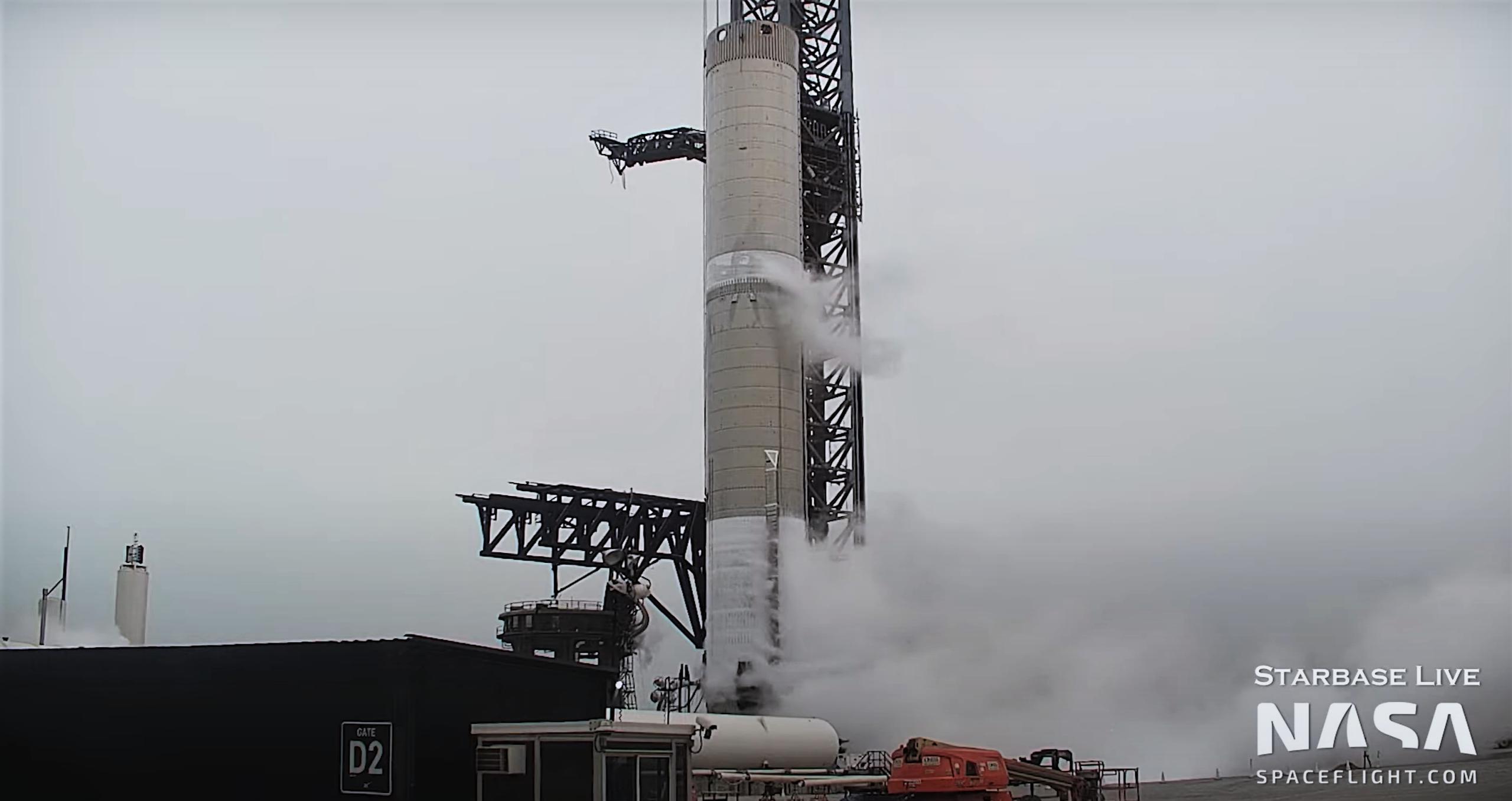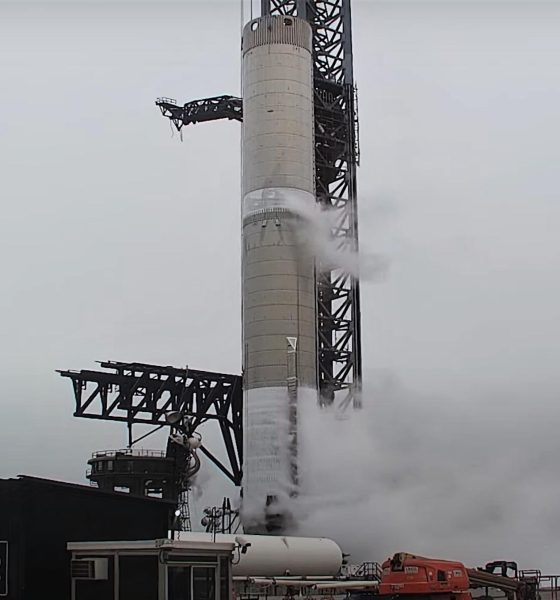

News
SpaceX begins stress-testing upgraded Super Heavy booster
In a what is likely a prelude to engine installation, SpaceX has begun stress-testing an upgraded Super Heavy booster prototype.
Known as Super Heavy Booster 7 or B7, the prototype is the first of its kind designed to support up to 33 new Raptor V2 engines – each potentially capable of producing up to 230 tons (~510,000 lbf) of thrust at liftoff. Even with just 20 such engines installed, Super Heavy – measuring around 69 meters (~225 ft) tall and nine meters (~30 ft) wide – will be the largest and most powerful rocket stage ever tested. That potentially unprecedented power is why SpaceX has custom-built a complex structural test stand to explore Super Heavy’s true performance envelope in a slightly less risky manner.
In the second half of 2021, that structural test stand briefly tested an unusual half-Starship, half-Super Heavy test tank with a nine-engine thrust section (‘puck’) and later compressed a different test tank until its reinforced steel skin buckled. In the interim, SpaceX removed its nine-ram setup and modified the stand to support 13 rams, guaranteeing that its new purpose was to test Super Heavy’s new 13-engine thrust section. Prior to Booster 7, all Super Heavy prototypes have had a similar nine-engine puck and an outer ring of 20 engines that would attach directly to the rim of each booster’s cylindrical body.
Increasing the central engine count from 9 to 13 was already certain to up the amount of stress future Super Heavy thrust pucks would need to survive by almost 45%. But combined with Raptor V2’s thrust increases, Super Heavy Booster 7’s thrust puck could actually be subjected to at least 80% more thrust at liftoff. Altogether, Super Heavy B7’s 33 engines should be able to produce ~7600 tons (~16.8M lbf) of thrust compared to Super Heavy B4’s ~5400 tons (~11.9M lbf). As a result, though it’s odd that SpaceX never did significantly test Booster 4, it’s no surprise that the company chose to give Booster 7 priority as soon it was ready.
After a few false starts and at least one ‘pneumatic proof test’ that likely saw Booster 7 pressurized with benign nitrogen gas, SpaceX began stress-testing the upgraded Super Heavy in earnest on April 14th. First, the booster was filled about a third of the way with roughly 1000 tons (~2.2M lb) of liquid nitrogen (LN2) or a combination of liquid oxygen (LOx) and LN2. Once the rocket was fully chilled, there were clear signs of some kind of added stress as large sheets of ice that had formed on the side of B7’s skin broke apart and fell off.
Only ice close to Super Heavy’s base was visibly disturbed, increasing the odds that the behavior was a sign of some or all of the structural test stand’s hydraulic rams simulating Raptor engines. It’s also possible that the stress was caused by pressurizing Super Heavy’s tanks to the point that they began to appreciably deform, though that type of testing is far harder to differentiate. Without official comments, it’s unfortunately impossible to ever know what exactly SpaceX is testing or how successful those tests are when the structural test stand is involved.
Nonetheless, it’s likely that Booster 7 isn’t done with the stand just yet. SpaceX could benefit from just about any data gathered about the performance of Super Heavy’s new thrust puck during simulated Raptor startup, throttling, and shutdown both at liftoff and during boostback and landing burns. SpaceX might also want to simulate engine-out scenarios that would result in asymmetric thrust.
Assuming Booster 7 survives this particular series of tests and SpaceX is happy with its performance on the structural test stand, the upgraded Super Heavy could be ready for Raptor installation and integrated wet dress rehearsal and static fire testing in the near future. SpaceX began delivering upgraded Raptors V2 engines to Starbase in late March.

Elon Musk
Starlink passes 9 million active customers just weeks after hitting 8 million
The milestone highlights the accelerating growth of Starlink, which has now been adding over 20,000 new users per day.

SpaceX’s Starlink satellite internet service has continued its rapid global expansion, surpassing 9 million active customers just weeks after crossing the 8 million mark.
The milestone highlights the accelerating growth of Starlink, which has now been adding over 20,000 new users per day.
9 million customers
In a post on X, SpaceX stated that Starlink now serves over 9 million active users across 155 countries, territories, and markets. The company reached 8 million customers in early November, meaning it added roughly 1 million subscribers in under seven weeks, or about 21,275 new users on average per day.
“Starlink is connecting more than 9M active customers with high-speed internet across 155 countries, territories, and many other markets,” Starlink wrote in a post on its official X account. SpaceX President Gwynne Shotwell also celebrated the milestone on X. “A huge thank you to all of our customers and congrats to the Starlink team for such an incredible product,” she wrote.
That growth rate reflects both rising demand for broadband in underserved regions and Starlink’s expanding satellite constellation, which now includes more than 9,000 low-Earth-orbit satellites designed to deliver high-speed, low-latency internet worldwide.
Starlink’s momentum
Starlink’s momentum has been building up. SpaceX reported 4.6 million Starlink customers in December 2024, followed by 7 million by August 2025, and 8 million customers in November. Independent data also suggests Starlink usage is rising sharply, with Cloudflare reporting that global web traffic from Starlink users more than doubled in 2025, as noted in an Insider report.
Starlink’s momentum is increasingly tied to SpaceX’s broader financial outlook. Elon Musk has said the satellite network is “by far” the company’s largest revenue driver, and reports suggest SpaceX may be positioning itself for an initial public offering as soon as next year, with valuations estimated as high as $1.5 trillion. Musk has also suggested in the past that Starlink could have its own IPO in the future.
News
NVIDIA Director of Robotics: Tesla FSD v14 is the first AI to pass the “Physical Turing Test”
After testing FSD v14, Fan stated that his experience with FSD felt magical at first, but it soon started to feel like a routine.

NVIDIA Director of Robotics Jim Fan has praised Tesla’s Full Self-Driving (Supervised) v14 as the first AI to pass what he described as a “Physical Turing Test.”
After testing FSD v14, Fan stated that his experience with FSD felt magical at first, but it soon started to feel like a routine. And just like smartphones today, removing it now would “actively hurt.”
Jim Fan’s hands-on FSD v14 impressions
Fan, a leading researcher in embodied AI who is currently solving Physical AI at NVIDIA and spearheading the company’s Project GR00T initiative, noted that he actually was late to the Tesla game. He was, however, one of the first to try out FSD v14.
“I was very late to own a Tesla but among the earliest to try out FSD v14. It’s perhaps the first time I experience an AI that passes the Physical Turing Test: after a long day at work, you press a button, lay back, and couldn’t tell if a neural net or a human drove you home,” Fan wrote in a post on X.
Fan added: “Despite knowing exactly how robot learning works, I still find it magical watching the steering wheel turn by itself. First it feels surreal, next it becomes routine. Then, like the smartphone, taking it away actively hurts. This is how humanity gets rewired and glued to god-like technologies.”
The Physical Turing Test
The original Turing Test was conceived by Alan Turing in 1950, and it was aimed at determining if a machine could exhibit behavior that is equivalent to or indistinguishable from a human. By focusing on text-based conversations, the original Turing Test set a high bar for natural language processing and machine learning.
This test has been passed by today’s large language models. However, the capability to converse in a humanlike manner is a completely different challenge from performing real-world problem-solving or physical interactions. Thus, Fan introduced the Physical Turing Test, which challenges AI systems to demonstrate intelligence through physical actions.
Based on Fan’s comments, Tesla has demonstrated these intelligent physical actions with FSD v14. Elon Musk agreed with the NVIDIA executive, stating in a post on X that with FSD v14, “you can sense the sentience maturing.” Musk also praised Tesla AI, calling it the best “real-world AI” today.
News
Tesla AI team burns the Christmas midnight oil by releasing FSD v14.2.2.1
The update was released just a day after FSD v14.2.2 started rolling out to customers.

Tesla is burning the midnight oil this Christmas, with the Tesla AI team quietly rolling out Full Self-Driving (Supervised) v14.2.2.1 just a day after FSD v14.2.2 started rolling out to customers.
Tesla owner shares insights on FSD v14.2.2.1
Longtime Tesla owner and FSD tester @BLKMDL3 shared some insights following several drives with FSD v14.2.2.1 in rainy Los Angeles conditions with standing water and faded lane lines. He reported zero steering hesitation or stutter, confident lane changes, and maneuvers executed with precision that evoked the performance of Tesla’s driverless Robotaxis in Austin.
Parking performance impressed, with most spots nailed perfectly, including tight, sharp turns, in single attempts without shaky steering. One minor offset happened only due to another vehicle that was parked over the line, which FSD accommodated by a few extra inches. In rain that typically erases road markings, FSD visualized lanes and turn lines better than humans, positioning itself flawlessly when entering new streets as well.
“Took it up a dark, wet, and twisty canyon road up and down the hill tonight and it went very well as to be expected. Stayed centered in the lane, kept speed well and gives a confidence inspiring steering feel where it handles these curvy roads better than the majority of human drivers,” the Tesla owner wrote in a post on X.
Tesla’s FSD v14.2.2 update
Just a day before FSD v14.2.2.1’s release, Tesla rolled out FSD v14.2.2, which was focused on smoother real-world performance, better obstacle awareness, and precise end-of-trip routing. According to the update’s release notes, FSD v14.2.2 upgrades the vision encoder neural network with higher resolution features, enhancing detection of emergency vehicles, road obstacles, and human gestures.
New Arrival Options also allowed users to select preferred drop-off styles, such as Parking Lot, Street, Driveway, Parking Garage, or Curbside, with the navigation pin automatically adjusting to the ideal spot. Other refinements include pulling over for emergency vehicles, real-time vision-based detours for blocked roads, improved gate and debris handling, and Speed Profiles for customized driving styles.








